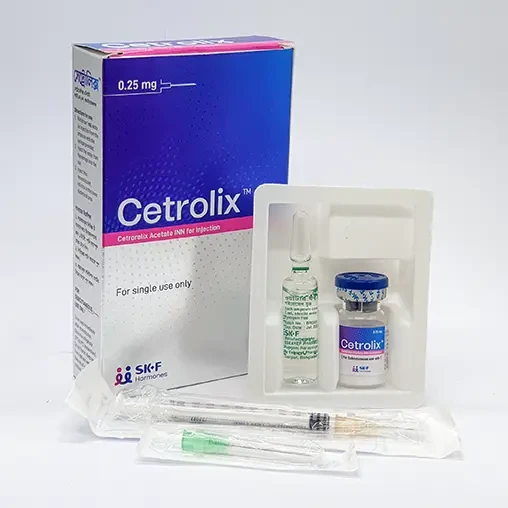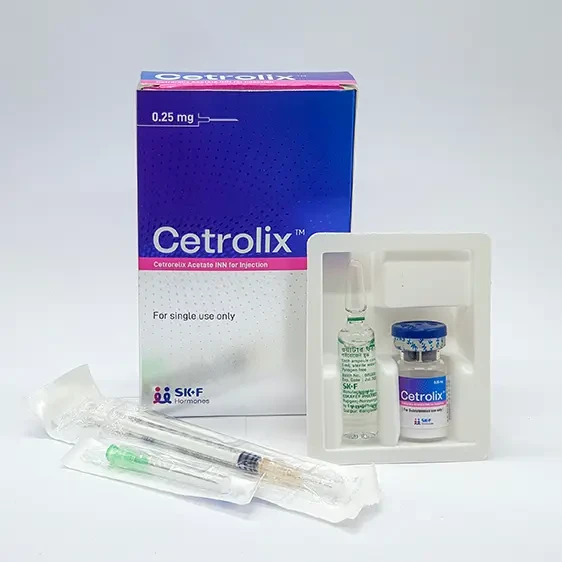250 mcg vial:
৳ 2,500.00
Indications
Cetrolix is indicated for the treatment of infertility in females. It restricts eggs to release directly and prevents premature ovulation. In Female infertility, Cetrolix prevents release of premature eggs during a process called ovulation in females. This helps in normal development of an egg in a woman's ovary (female reproductive organ), and stimulates the release of a healthy, matured egg. This helps to treat infertility in women and increases the chance of a successful pregnancy.
* রেজিস্টার্ড চিকিৎসকের পরামর্শ মোতাবেক ঔষধ সেবন করুন
Pharmacology
Cetrorelix Acetate is a synthetic decapeptide with gonadotropin-releasing hormone (GnRH) antagonistic activity. Cetrorelix Acetate blocks the effects of GnRH. GnRH controls the secretion of luteinizing hormone (LH), which induces ovulation during the menstrual cycle. During hormone treatment for ovarian stimulation, premature ovulation may lead to eggs that are not suitable for fertilization. Cetrorelix Acetate blocks such undesirable premature ovulation. GnRH induces the production and release of luteinizing hormone (LH) and follicle stimulating hormone (FSH) from the gonadotropic cells of the anterior pituitary. Due to a positive estradiol (E2) feedback at midcycle, GnRH liberation is enhanced resulting in an LH-surge. This LH-surge induces the ovulation of the dominant follicle, resumption of oocyte meiosis and subsequently luteinization as indicated by rising progesterone levels.
Cetrorelix Acetate competes with natural GnRH for binding to membrane receptors on pituitary cells and thus controls the release of LH and FSH in a dose-dependent manner. The onset of LH suppression is approximately two hours with the 0.25 mg dose. This suppression is maintained by continuous treatment and there is a more pronounced effect on LH than on FSH. An initial release of endogenous gonadotropins has not been detected with Cetrorelix injection, which is consistent with an antagonist effect.
The effects of Cetrorelix Acetate on LH and FSH are reversible after discontinuation of treatment. In women, Cetrorelix Acetate delays the LH-surge, and consequently ovulation, in a dose dependent fashion. FSH levels are not affected at the doses used during controlled ovarian stimulation. A dose of Cetrorelix Acetate 0.25 mg every 24 hours has been shown to maintain the effect.
Cetrorelix Acetate competes with natural GnRH for binding to membrane receptors on pituitary cells and thus controls the release of LH and FSH in a dose-dependent manner. The onset of LH suppression is approximately two hours with the 0.25 mg dose. This suppression is maintained by continuous treatment and there is a more pronounced effect on LH than on FSH. An initial release of endogenous gonadotropins has not been detected with Cetrorelix injection, which is consistent with an antagonist effect.
The effects of Cetrorelix Acetate on LH and FSH are reversible after discontinuation of treatment. In women, Cetrorelix Acetate delays the LH-surge, and consequently ovulation, in a dose dependent fashion. FSH levels are not affected at the doses used during controlled ovarian stimulation. A dose of Cetrorelix Acetate 0.25 mg every 24 hours has been shown to maintain the effect.
Dosage
Cetrorelix Acetate administered subcutaneously once daily (0.25 mg dose) at 24 hour intervals, either in the morning or in the evening as part of the multiple dose protocol during the early-to mid-follicular phase (Day 5/6 to Day11). It is for subcutaneous injection into the lower abdominal wall. The first administration of Cetrorelix Acetate 0.25 mg should be performed under the supervision of a physician. The reconstituted product is to be administered subcutaneously. Use immediately after reconstitution.
* রেজিস্টার্ড চিকিৎসকের পরামর্শ মোতাবেক ঔষধ সেবন করুন
Administration
Choose an injection site on your lower abdominal area. It should be preferably around, but at least one inch away, from your belly button. Choose a different injection site each day to minimize local irritation. Take the second alcohol wipe, clean the skin at the injection site and allow the alcohol to dry. Keep the alcohol wipe nearby.
Pick up the syringe. Invert the syringe and hold it as if 'throwing a dart'. With your other hand, gently squeeze the skin together to make a little elevation at the injection site. Using a 'dart like motion', slowly insert the needle at an angle of about 45° to 90° (you need very little force but quick action).
Once the needle is inserted into the tissue all the way, inject the solution. Do this by pushing gently on the plunger with your thumb of the hand holding the syringe. Take as much time as you need to inject all the solution.
Immediately withdraw the needle. Clean the injection site with the clean side of the alcohol pad using a circular motion. If there is minor oozing, you may need to apply a small amount of pressure for a minute.
Use the syringe and needles only once. Dispose of the syringe and needles immediately after use. Discard into a disposal container or puncture-proof container with a lid that fits firmly.
Pick up the syringe. Invert the syringe and hold it as if 'throwing a dart'. With your other hand, gently squeeze the skin together to make a little elevation at the injection site. Using a 'dart like motion', slowly insert the needle at an angle of about 45° to 90° (you need very little force but quick action).
Once the needle is inserted into the tissue all the way, inject the solution. Do this by pushing gently on the plunger with your thumb of the hand holding the syringe. Take as much time as you need to inject all the solution.
Immediately withdraw the needle. Clean the injection site with the clean side of the alcohol pad using a circular motion. If there is minor oozing, you may need to apply a small amount of pressure for a minute.
Use the syringe and needles only once. Dispose of the syringe and needles immediately after use. Discard into a disposal container or puncture-proof container with a lid that fits firmly.
* রেজিস্টার্ড চিকিৎসকের পরামর্শ মোতাবেক ঔষধ সেবন করুন
Interaction
No formal drug-drug interaction studies have been performed with Cetrolix. In vitro investigations have shown that interactions are unlikely with medicinal products that are metabolized by cytochrome P450 or glucuronised or conjugated in some other way. However, the possibility of interactions with gonadotropins or medicinal products that may induce histamine release in susceptible individuals, cannot be totally excluded.
Contraindications
- Hypersensitivity to cetrorelix acetate, extrinsic peptide hormones or mannitol.
- Pregnancy and lactation.
- Postmenopausal women.
- Patients with moderate and severe renal and hepatic impairment
Side Effects
The most commonly reported adverse effects are local injection site reactions such as erythema, swelling and pruritus that are usually transient in nature and mild in intensity. Mild to moderate ovarian hyperstimulation syndrome (OHSS) (WHO grade I or II) have been commonly reported and should be considered as an intrinsic risk of the stimulation procedure.
Pregnancy & Lactation
Cetrorelix Acetate is not intended to be used during pregnancy and lactation.
Precautions & Warnings
- This medicinal product must be allowed to reach room temperature prior to injection. It should be removed from the refrigerator approximately 30 minutes before use.
- Do not use if the reconstituted solution contains particles or if the solution is not clear.
- The solution should be used immediately after reconstitution.
Overdose Effects
If you think you have taken too much Cetrolix, contact your healthcare professional, hospital emergency department or regional poison control centre immediately, even if there are no symptoms.
Therapeutic Class
Drugs affecting (inhibiting) gonadotrophin
Reconstitution
- Wash your hands well with soap and water.
- On a clean surface, lay out everything you need: one vial of Cetrolix, one ampoule of WFI, one disposable syringe with light brown (26G) injection needle, one green (21G) injection needle and two alcohol pads.
- Flip off the plastic cover of the Cetrolix vial. Clean the aluminum ring and rubber stopper with an alcohol wipe. Discard the alcohol pad.
- Take the disposable syringe, remove the wrapping and remove the attached light brown (26G) syringe needle and put the needle on a clean surface.
- Take the green (21G) injection needle, remove the wrapping and put this green needle on the syringe.
- Take 1 mL of WFI from the ampoule using the syringe.
- Push the needle through the center of the rubber stopper of the vial of Cetrolix. Inject the water from the syringe into the vial by slowly pushing down the plunger of the syringe. Dissolve Cetrolix powder only with the water contained in the syringe.
- Without removing the needle from the vial, gently shake or rotate the vial until the solution is clear and without particles. Avoid forming bubbles.
- Draw all of the liquid in the vial into the syringe. If the liquid is left in the vial, invert the vial, pull back the needle until the opening of the needle is just inside the stopper. If you look from the side through the gap in the stopper, you can control the movement of the needle and the liquid. It is important to withdraw the entire contents of the vial. Be careful not to pull the plunger out of the syringe.
- Detach the green needle from the syringe and put the light brown (26G) injection needle on the syringe and remove the cover of the needle.
- Invert the syringe and push the plunger until all the air bubbles have been pushed out. Do not touch the needle or allow the needle to touch any surface.
Storage Conditions
To be used immediately after reconstitution. Store in a refrigerator (2°C to 8°C temperature). Do not freeze. Keep away from light & wet place. Keep out of reach of children.
Pack Images: Cetrolix 250 mcg Injection


